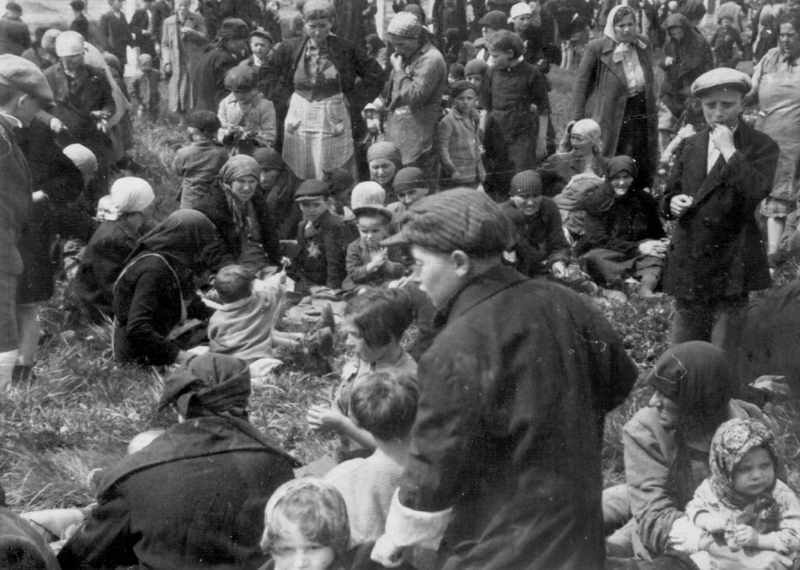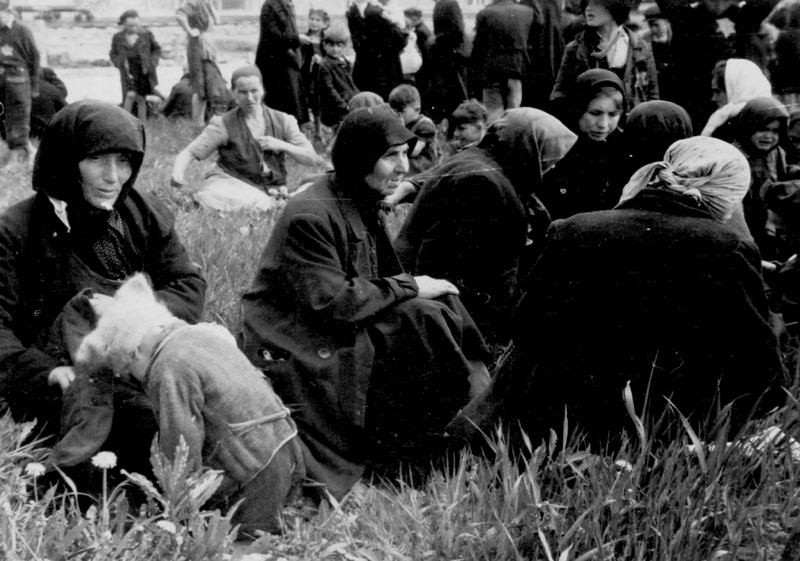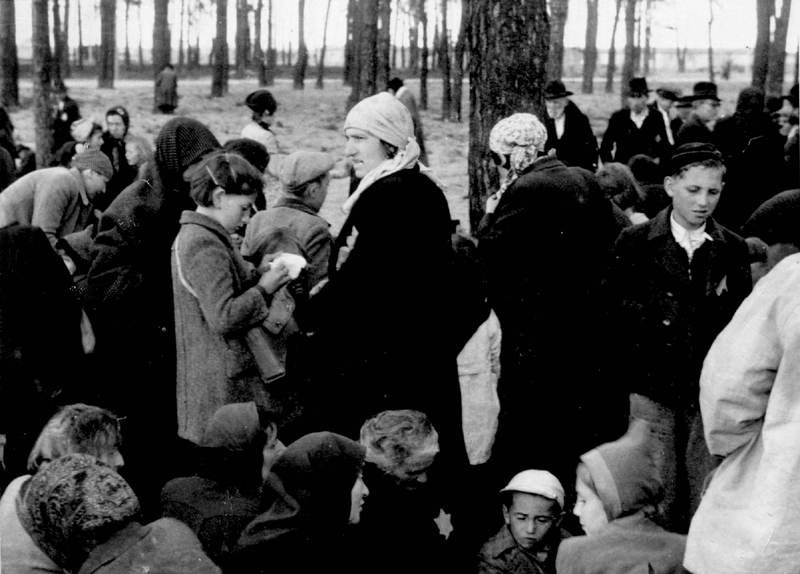- Sometimes spelled "Lilly."
- Peter Hellman, The Auschwitz Album (New York: Random House, Inc., 1981), p. xx. Lili was married twice; her married name was Lili Jacob Zelmanovic Meier.
- Hellman, The Auschwitz Album, p. 156, from an account of the arrival of Hungarian Jews in June of 1944.
When World War II ended in the spring of 1945, Lili1 Jacob was a young Jewish girl of about eighteen, physically broken. She weighed only 80 pounds and fell victim to typhus at Dora, a Nazi slave labor camp, after a death march from Auschwitz to one labor camp after another. After a few days in the clinic, Lili heard shouts, “The Americans are here!” She got up to see for herself, but collapsed before she could get very far. Fellow prisoners carried her into a barrack at the camp that had previously been an SS barrack. When she came to, she was cold. She looked through a cupboard in the room for a blanket or a sweater – something to put on to keep her warm. She found a pajama top. Underneath it was a photo album with a cloth cover. She put on the top and went back to sleep. When she woke up later she remembered to be curious about the album. She opened it. Though over a million people had been brought to Auschwitz in thousands of trainloads, the first picture Lili saw when she opened the album was the Rabbi of her little town of Bilke in the Carpathian Mountains in Hungary, Rabbi Naftali Zvi Weiss. Other pages in the album contained pictures of her brothers, who had been ripped away from her on the ramp at Auschwitz-Birkenau, the last place she saw her family. Her grandparents were in the album, as well, and there was even a picture of Lili herself, dressed in foreign clothing with her head shaved, after she had been processed in the “sauna” as a new prisoner at Birkenau. From that point on, Lili held tightly onto the album – it was like having a family album as a substitute for the family she had lost. A month later, Lili began her journey towards home. At security checkpoints she passed on her way back to Hungary from Germany, she shrieked when soldiers tried to confiscate the album. She held onto the album for thirty-five years, believing that it was fate that it had fallen into her hands. In 1980, Lili donated the album to Yad Vashem.2 It is commonly referred to as The Auschwitz Album >>>
The Auschwitz Album is the only surviving visual evidence of the process of mass murder at Auschwitz-Birkenau. It is a unique document.
The photos were taken at the end of May, 1944. They show the arrival of Hungarian Jews from Carpatho-Ruthenia. Many of them came from the Berehovo Ghetto, which itself was a collecting point for Jews from several other small towns – like Lili’s town of Bilke.
Early summer 1944 was the apex of the deportation of Hungarian Jewry. The Jews of Hungary arrived on a special rail line that had been extended from the railway station outside the camp to a ramp inside Birkenau, just a few minutes' walk to the gas chambers. Many of the photos in the album were taken on the ramp. The Jews then went through a selection process, carried out by SS doctors and wardens. Those considered fit for work were sent into the camp, where they were registered, deloused and distributed among the barracks – as was Lili. The rest were sent directly to the gas chambers without being registered.
The Nazis not only ruthlessly exploited the labor of those they did not kill immediately, they also looted the belongings the Jews brought with them. Even gold fillings were extracted from the mouths of the dead by a special detachment of inmates. The personal effects the Jews brought with them were sorted by inmates and stored in an area referred to by the inmates as "Canada": the ultimate land of plenty.
The photos in the Auschwitz Album show the disembarkation and the chaos on the ramp; they show the process of “selection” where the fates of those who had just arrived were sealed by the SS by means of a single finger pointed in the wrong direction. They show the prisoners who had been selected for slave labor, dressed in uniforms or in clothing looted from those previously murdered in the camp, and they show the prisoners of the “Canada Kommando” trying to make order of the mountains of suitcases, shoes, clothing and other personal possessions that the murder victims brought with them.
The photographs in the Auschwitz Album show the entire process except for the killing itself. None of the pictures in the album gives any hint of violence or death. These are the two elements that are completely absent from the pictures – as if there was no violence or death in Auschwitz at all.
The purpose of the album remains a mystery even to this day. It was not intended for propaganda purposes, nor does it have any obvious personal use. One assumes that it was prepared as an official reference for a higher authority, as were photo albums from other concentration camps. The photos were taken either by Ernst Hoffmann or by Bernhard Walter, two SS men whose task was to take ID photos and fingerprints of the inmates (not of the Jews who were sent directly to the gas chambers).
The Auschwitz Album is a perfect example of the importance of knowing the context in which photographs were taken. For instance, the picture below is an innocent picture of women standing together in front of a building. They stand together with their babies and children, and seem happy to look at the photographer who is taking the picture. There is no sign of stress, no hint of violence; most of the women are calm – all except one who looks like she is trying to comfort a fussy baby.
Yet, because we have the benefit of research, we know that these women are standing in front of one of the four massive extermination installations at Birkenau – Crematorium number III (if the four installations are counted from II through V). In the gas chamber of this building (which is located below ground, perpendicular to where the women are standing), two thousand people at a time could be murdered. Behind the double windows of the building visible in the picture are fifteen ovens, vented through the chimney that is partly visible in the upper left-hand corner of the photo, used to turn the bodies of the unsuspecting victims (like those in the photo) into ash. Behind the smaller, dormer windows on the upper floor of the building are the living quarters of the Sonderkommando, those most miserable of prisoners, whose job included emptying the gas chambers of the bodies, removing any dental gold that was found in their teeth, and burning them in the ovens.
Judging by their expressions, the women who are standing in front of the crematorium do not suspect that this is their last hour of life. Yet the photographer who purposely framed the women against the background of the crematorium was well aware of what he was doing. Perhaps he was trying to show how well German deception worked – so close to death and still these women are unaware of what is to befall them. Perhaps the photographer was actually mocking these women, who have no idea what they are standing in front of. In any event, without understanding the context, there is no reason to believe that this is anything but an innocent picture.
Another series of pictures in the album has a similar effect. These pictures seem to show a picnic in a grove of trees. Again, the people who are the subjects of the photos are calm. They are sitting in groups – presumably groups of family or friends. They are chatting with each other. In some cases, the adults or their children are eating. These people have disembarked from the cattlecars after a long ride in cramped and fetid conditions, and were no doubt happy to stretch their legs and breath the air; they were happy, as well, to picnic in the grass. In one case, a little child picks a flower growing where he sits and extends his or her arm to give it to what might be his older brother.

Birkenau, Poland, May, 1944, Jews waiting in a grove near gas chamber number four prior to their extermination (detail)

Birkenau, Poland, May, 1944, Jews waiting in a grove near gas chamber number four prior to their extermination

Birkenau, Poland, May, 1944, Jews waiting in a grove near gas chamber number four prior to their extermination
.jpg)
Jews who were classified as "not fit for work" waiting in a grove outside Crematorium IV before they were to be gassed
These photos were taken in the birch grove that gave the camp its name (“Birkenau” in German means birch trees), in the northwestern corner of the camp. In the spring and summer of 1944, when the influx of prisoners from Hungary and Lodz was at its peak, the gas chambers and crematoria could not keep up with the volume of victims. Many who had just come out of the cattlecars were sent to the birch grove to wait their turn for the gas chambers. That is what these people are doing. The birch grove is very close to two of the monstrous killing facilities, Crematoria numbers IV and V – but neither the adults nor the children know this. They are literally in the shadow of the crematorium. “The imagination of the people could not possibly envisage that the smoke clouding the sun, the huge fire raging from behind the screen and the sickly smell polluting the air came from the burning of thousands of murdered human beings who, only a few hours earlier, had suffered the fate now awaiting them.”3
Again, we have the problem of context – without knowing where these people are, or what they are waiting for, we would have no reason to suspect anything untoward was about to happen. Yet again, the photographer intentionally photographed these unsuspecting people as naturally as he could, though he was fully aware of what awaited them. Either these pictures show an incredible pride in the German machinery of death and deception, or they show the incredible, cold-blooded cynicism of the photographer who is preserving the images of these people though he knows they are moments from their doom. Could anything be more natural – or hopeful – than a child picking a flower for his older sibling?
Disembarkation from a train, women and children standing together and squinting into the sunlight, picnics in a grassy field: without knowing where these pictures were taken or what process they depict, one could easily be convinced that nothing suspicious was going on. It is only because we are aware of the context that we understand how valuable these pictures are as the only testament to the process that directly preceded mass murder at Birkenau.
- 3. 3






